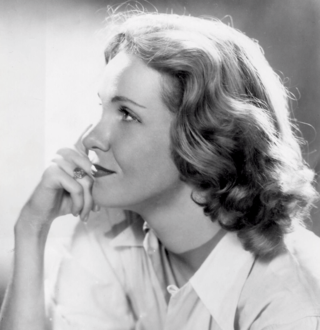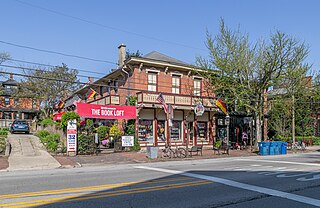
Edward St. John Gorey was an American writer, Tony Award-winning costume designer, and artist, noted for his own illustrated books as well as cover art and illustration for books by other writers. His characteristic pen-and-ink drawings often depict vaguely unsettling narrative scenes in Victorian and Edwardian settings.

Truman Garcia Capote was an American novelist, screenwriter, playwright and actor. Several of his short stories, novels, and plays have been praised as literary classics, including the novella Breakfast at Tiffany's (1958) and the true crime novel In Cold Blood (1966), which he labeled a "non-fiction novel". His works have been adapted into more than 20 films and television dramas.

Barnes & Noble Booksellers is an American bookseller. It is a Fortune 1000 company and the bookseller with the largest number of retail outlets in the United States. As of July 7, 2020, the company operates 614 retail stores across all 50 U.S. states.

City Lights is an independent bookstore-publisher combination in San Francisco, California, that specializes in world literature, the arts, and progressive politics. It also houses the nonprofit City Lights Foundation, which publishes selected titles related to San Francisco culture. It was founded in 1953 by poet Lawrence Ferlinghetti and Peter D. Martin. Both the store and the publishers became widely known following the obscenity trial of Ferlinghetti for publishing Allen Ginsberg's influential collection Howl and Other Poems. Nancy Peters started working there in 1971 and retired as executive director in 2007. In 2001, City Lights was made an official historic landmark. City Lights is located at 261 Columbus Avenue. While formally located in Chinatown, it self-identifies as part of immediately adjacent North Beach.

Waldenbooks, operated by the Walden Book Company, Inc., was an American shopping mall-based bookstore chain, from 1995 as a subsidiary of Borders Group. The chain also ran a video game and software chain under the name Waldensoftware, as well as a children's educational toy chain under Walden Kids. In 2011, the chain was liquidated in bankruptcy.
Leonard Alan Lauder is an American billionaire, philanthropist, art collector. He and his brother, Ronald Lauder, are the sole heirs to the Estée Lauder Companies cosmetics fortune, founded by their parents, Estée Lauder and Joseph Lauder, in 1946. Having been its CEO until 1999, Lauder is the chairman emeritus of The Estée Lauder Companies Inc. During his tenure as the CEO, the company went public at The New York Stock Exchange in 1996 and acquired several major cosmetics brands, including MAC Cosmetics, Aveda, Bobbi Brown, and La Mer.

An independent bookstore is a retail bookstore which is independently owned. Usually, independent stores consist of only a single actual store. They may be structured as sole proprietorships, closely held corporations or partnerships, cooperatives, or nonprofits. Independent stores can be contrasted with chain bookstores, which have many locations and are owned by large corporations, which often have other divisions besides bookselling.

Brentano's was an American bookstore chain with numerous locations in the United States.
The non-fiction novel is a literary genre that, broadly speaking, depicts non-fictional elements, such as real historical figures and actual events, woven together with fictitious conversations and uses the storytelling techniques of fiction. The non-fiction novel is an otherwise loosely defined and flexible genre. The genre is sometimes referred to using the slang term "faction", a portmanteau of the words fact and fiction.

The Charles Scribner's Sons Building, also known as 597 Fifth Avenue, is a commercial structure in the Midtown Manhattan neighborhood of New York City, on Fifth Avenue between 48th and 49th Streets. Designed by Ernest Flagg in a Beaux Arts style, it was built from 1912 to 1913 for the Scribner's Bookstore.

Ida Frances Stelov, better known as Frances "Fanny" Steloff, was the founder of the Gotham Book Mart in New York City, a center for avant-garde literature and literati from 1920 until it closed in 2007.
Book store shoplifting is a problem for book sellers and has sometimes led stores to keep certain volumes behind store counters.

The Doubtful Guest is a short, illustrated book by Edward Gorey, first published by Doubleday in 1957. It is the third of Gorey's books and shares with his others a sense of the absurd, meticulous cross-hatching, and a seemingly Edwardian setting. The book begins with the sudden appearance of a strange, penguin-like creature in a turn-of-the-century manor house. An aristocratic family struggles to coexist with the creature, who is by turns despondent and mischievous. By the final page, the guest has stayed for seventeen years, and shows "no intention of going away".

The Argosy Book Store is New York City's oldest independent bookstore. Located at 116 East 59th Street in Midtown Manhattan, it occupies an entire six-story townhouse with various sales floors specializing in first editions, Americana, leather bindings, antique maps and prints, and autographs. The store, also noted for a wide selection of bargain books, has its own framing and shipping departments and owns a large warehouse in Brooklyn.
BooksActually was an independent bookstore that operated online. It was formerly located in Singapore's Tiong Bahru district till 2020.

Geraldine Page was an American actress who earned critical recognition as a stage actress on Broadway as well as in feature films and television. Over the course of her career, which spanned over three decades, Page earned a total of eight Academy Award nominations, three Emmy nominations, and four Tony nominations. She won the Academy Award for Best Actress for her performance in The Trip to Bountiful (1985).
Russell Books is an independent bookstore in Victoria, British Columbia, Canada. A family-owned business still owned and operated by the children and grandchildren of its founder, it has been labelled as the largest used bookstore in Canada.

The Book Loft of German Village is an independent bookstore in the German Village neighborhood of Columbus, Ohio. Opened in 1977 and described by the Columbus Business First as "iconic" and a "tourist destination", the store has also been called "a national treasure" by The New York Times. The Book Loft has been described by visitors as a "literary labyrinth" due to its maze-like 32 rooms of books connected by narrow passageways and staircases.

Elliott Bay Book Company is an independent bookstore located at 1521 10th Avenue in the Capitol Hill neighborhood of Seattle, Washington. The Seattle Times described the store as the "region's premier independent bookstore" and the Associated Press referred to the bookstore as "a literary landmark." The New York Times claimed in 1999 that "most Seattleites would agree" that Elliott Bay Book Company was the "bookish heart" of the city. The bookstore opened in 1973 in the Pioneer Square neighborhood and moved to Capitol Hill in 2010.















